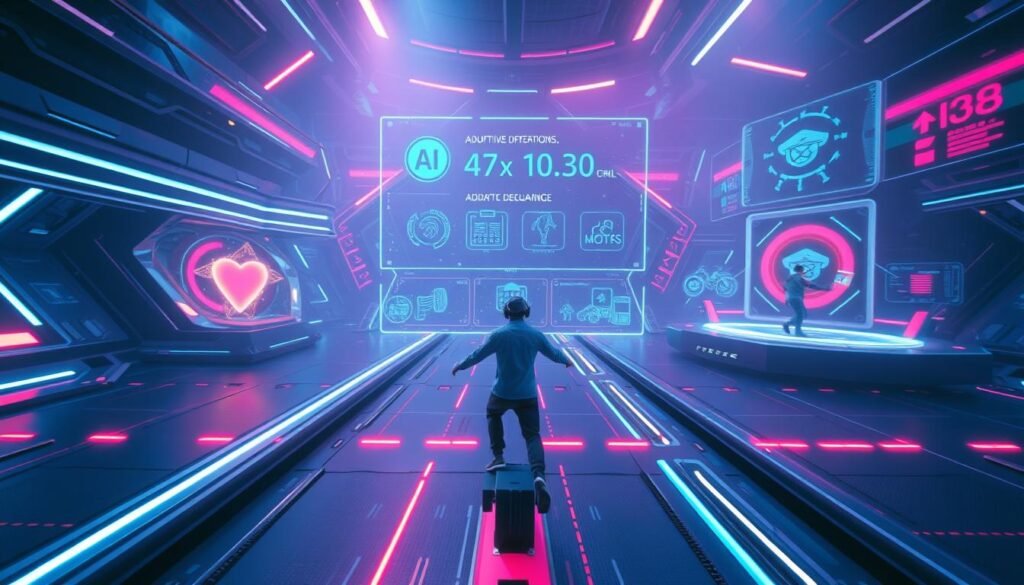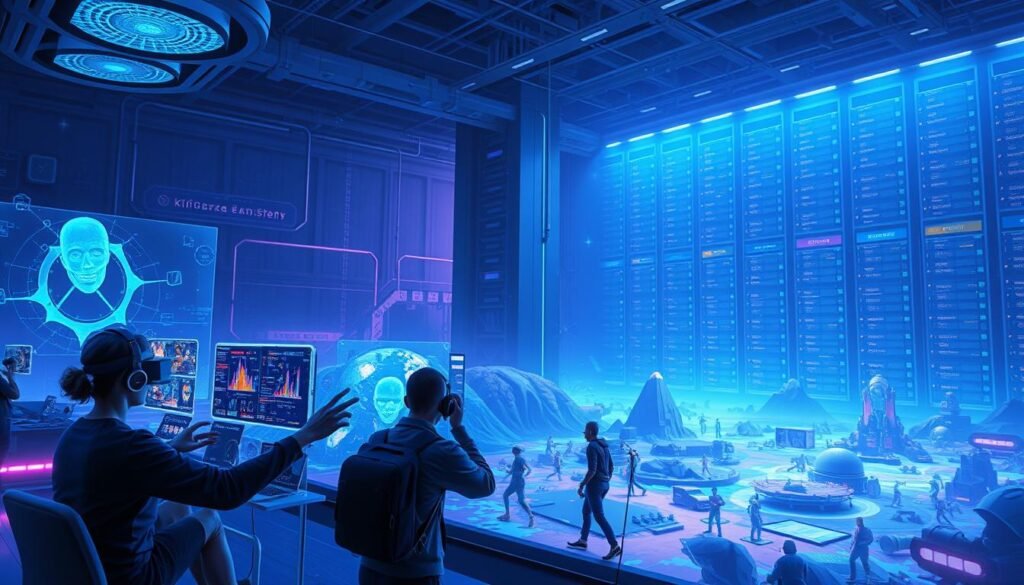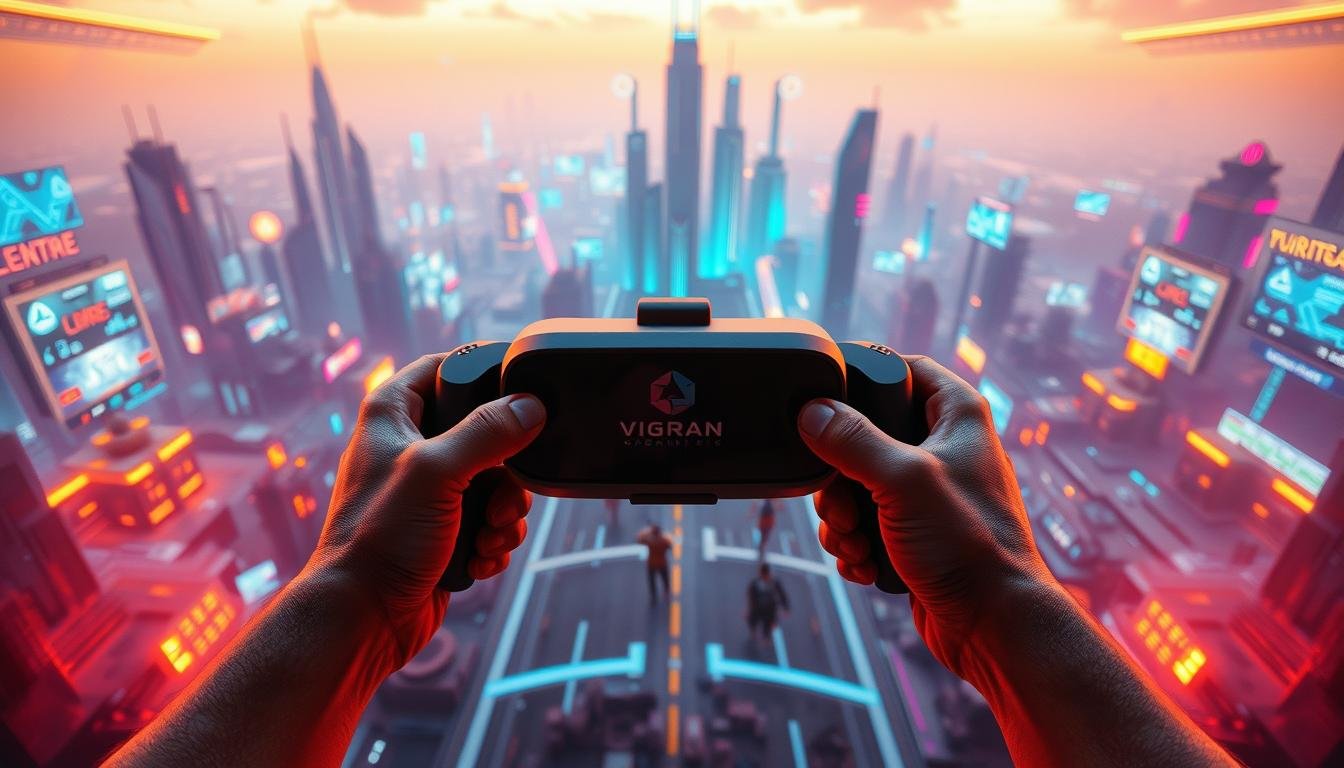Imagine stepping into a virtual reality world where every detail feels real. The environment around you reacts to your movements, and characters respond with lifelike expressions. This is no longer science fiction; it’s the future of gaming. The blend of artificial intelligence and virtual reality is transforming how you interact with digital spaces.
From the early days of pixelated screens to today’s immersive adventures, gaming has come a long way. AI now powers adaptive gameplay, creating dynamic experiences tailored to your actions. These advancements blur the line between fiction and reality, offering you a chance to explore new worlds like never before.
Experts like Anton Paramonov at Whimsy Games highlight how these technologies craft lifelike environments. The result? A future where gaming feels less like a pastime and more like stepping into another reality. Ready to dive deeper into this exciting evolution? Let’s explore what lies ahead.
Key Takeaways
- Artificial intelligence enhances immersive gaming experiences.
- Virtual reality creates lifelike digital environments.
- Adaptive gameplay tailors experiences to user actions.
- Technological advancements blur the line between fiction and reality.
- Experts predict a future of highly realistic gaming spaces.
The Convergence of AI and VR in the Gaming Landscape
The fusion of advanced technologies is reshaping the gaming landscape. Artificial intelligence and virtual reality are no longer separate entities; they now work together to create experiences that feel more personal and immersive than ever before.
Exploring Adaptive Gameplay and Immersion
Adaptive gameplay is one of the most exciting advancements in modern gaming. AI algorithms analyse your actions and adjust challenges in real time. This ensures that the game remains engaging, whether you’re a beginner or a seasoned player.
For example, if you’re excelling in a particular area, the game might introduce tougher opponents or complex puzzles. Conversely, if you’re struggling, it could offer hints or reduce difficulty. This tailored approach keeps you invested in the experience.
Immersive Storytelling and Dynamic Environments
Storytelling in games has also evolved dramatically. AI-driven narratives adapt to your decisions, ensuring that no two playthroughs are the same. Characters react to your choices, and the plot unfolds in unique ways based on your actions.
Dynamic environments further enhance immersion. AI-powered systems generate responsive worlds that change as you explore them. Weather patterns, NPC behaviours, and even the terrain can shift, making the game feel alive.
Games like No Man’s Sky showcase this brilliantly, offering countless procedurally generated worlds to discover. Each planet feels distinct, thanks to AI’s ability to create diverse ecosystems and landscapes.
This blend of adaptive gameplay and immersive storytelling is transforming the way you interact with games. The future of gaming lies in experiences that feel less like a scripted journey and more like a living, breathing world.
Tracing the Evolution: From Early Gaming to Immersive VR Worlds

The journey of gaming has evolved from simple pixels to immersive virtual realms. Early games relied on basic designs and limited interactions. Today, advancements in technology have transformed gaming into a lifelike experience, powered by sophisticated algorithms and AI-driven systems.
The Role of AI in NPC Development
Non-playable characters (NPCs) have come a long way. In the past, they followed scripted behaviours, offering little challenge or realism. Modern AI has revolutionised NPCs, making them more dynamic and responsive. These characters now adapt to your actions, creating a personalised experience.
For instance, AI-powered NPCs can learn from your gameplay style. If you prefer stealth, enemies might become more vigilant. This adaptability ensures that every player faces unique challenges, keeping the game engaging and unpredictable.
Enhancing Graphics and Creating Lifelike Worlds
Graphics have also seen remarkable improvements. Early games featured blocky visuals, but today’s virtual worlds are stunningly realistic. AI plays a crucial role here, enhancing textures, lighting, and environmental details. These advancements make the game world feel alive and immersive.
Developers use cutting-edge technology to create diverse landscapes and ecosystems. For example, AI algorithms generate realistic weather patterns and terrain changes. This level of detail ensures that every player feels fully immersed in the game.
| Aspect | Early Gaming | Modern Gaming |
|---|---|---|
| Graphics | Basic, pixelated | Hyper-realistic |
| NPC Behaviour | Scripted, repetitive | Dynamic, adaptive |
| Player Interaction | Limited | Personalised |
The evolution of virtual reality technology has been instrumental in this transformation. As gaming continues to evolve, the line between reality and virtual worlds will blur even further, offering experiences that were once unimaginable.
How AI is Changing the Future of VR Gaming

Real-time strategy and adaptive difficulty are redefining the gaming landscape. These advancements ensure that every action you take in a game is met with a tailored response, creating a personalised experience. The role of innovative algorithms in shaping virtual environments cannot be overstated.
Adaptive Difficulty and Real-Time Strategy
Adaptive difficulty ensures that games remain challenging yet accessible. If you’re excelling, the game introduces tougher opponents or complex puzzles. Conversely, if you’re struggling, it offers hints or reduces the difficulty. This dynamic approach keeps you engaged.
For example, in games like No Man’s Sky, the difficulty adjusts based on your progress. This ensures that every player faces unique challenges, making the experience more immersive and rewarding.
Innovative Algorithms Shaping Virtual Environments
Innovative algorithms are at the heart of modern gaming. They create responsive worlds that adapt to your actions. Weather patterns, NPC behaviours, and even terrain can shift in real time, making the game feel alive.
Case studies show how these advancements are transforming gameplay. For instance, AI-powered systems generate diverse ecosystems, ensuring that no two playthroughs are the same. This level of innovation offers endless possibilities for exploration.
| Aspect | Traditional Gaming | Modern Gaming |
|---|---|---|
| Difficulty | Fixed | Adaptive |
| Environment | Static | Dynamic |
| Player Interaction | Limited | Personalised |
The integration of advanced technologies is revolutionising gaming, offering experiences that were once unimaginable. As these advancements continue, the line between reality and virtual worlds will blur even further.
Pioneering Innovation in AI-Driven Game Development and Strategy

The gaming industry is witnessing a transformative shift, driven by cutting-edge innovations in technology. These advancements are redefining how games are developed, marketed, and experienced, pushing the boundary of what’s possible in virtual worlds.
Revolutionising Game Narratives and Procedural Content
Game narratives are no longer static. With AI, developers can create dynamic stories that adapt to your preference. Procedural content generation ensures that every playthrough feels unique, offering endless possibilities for exploration.
For instance, AI algorithms analyse your gameplay style to tailor challenges and story arcs. This practice enhances immersion, making the virtual world feel more alive and responsive to your actions.
Data-Driven Marketing and New Revenue Models
AI is also transforming how games are marketed. By analysing player data, companies can create targeted campaigns that resonate with your preference. This approach not only boosts engagement but also opens up new revenue streams.
Innovative models like microtransactions and subscription services are becoming more personalised. These strategies ensure that you get value while developers maintain profitability.
- AI-driven narratives adapt to your choices, offering a fresh experience every time.
- Procedural content breaks the boundary of traditional game design, creating diverse worlds.
- Data-driven marketing ensures campaigns align with your preference, enhancing engagement.
- New revenue models benefit both players and developers, fostering a sustainable ecosystem.
Developers are continuously refining algorithms through learning and practice, ensuring that games remain engaging and realistic. This balance between innovation and realism is key to creating immersive experiences that captivate players.
As these technologies evolve, the sense of immersion in virtual worlds will only deepen, offering you experiences that feel increasingly lifelike and boundless.
Ethical Considerations in the Age of AI and VR

As technology advances, ethical considerations in gaming become increasingly critical. The integration of AI and VR brings exciting possibilities but also raises important questions about fairness, privacy, and transparency. Developers must navigate these challenges to ensure that gaming remains enjoyable and ethical for everyone.
Mitigating AI Bias and Ensuring Fair Play
One of the most pressing ethical issues in gaming is AI bias. Algorithms can unintentionally favour certain user groups or create unfair difficulty levels. To address this, developers are adopting tools like Google’s What-If Tool and IBM’s AI Fairness 360 Toolkit. These help detect and minimise biases, ensuring a balanced experience for all players.
Robust testing and regular audits are also essential. By continuously monitoring algorithms, developers can safeguard character integrity and maintain game balance. This journey towards fairness requires ongoing effort and commitment.
Balancing Data Privacy with Personalised Experiences
Personalised gaming experiences rely heavily on datum collection. However, this raises concerns about user privacy. The General Data Protection Regulation (GDPR) sets strict standards for handling personal information, ensuring that players’ rights are protected.
Developers must strike a balance between personalisation and privacy. Transparent data policies and secure systems are key to building trust. As ethical challenges in VR continue to evolve, keeping these concerns at hand is crucial for sustainable growth.
| Aspect | Challenge | Solution |
|---|---|---|
| AI Bias | Unfair gameplay | Fairness tools & audits |
| Data Privacy | Personal data misuse | GDPR compliance |
| Game Balance | Inconsistent difficulty | Algorithm testing |
“Ethical gaming isn’t just a goal; it’s a responsibility. Developers must ensure that every player feels valued and respected.”
As the gaming industry evolves, ethical considerations will remain at the forefront. By addressing bias, ensuring fair play, and protecting user privacy, developers can create immersive experiences that are both enjoyable and responsible.
Conclusion
The gaming landscape is undergoing a remarkable transformation, driven by cutting-edge technologies. These advancements are reshaping the industry, offering unparalleled immersive experiences that redefine player interaction. From dynamic NPCs to adaptive gameplay, every element is designed to captivate and engage.
For companies, this era presents significant opportunities. Leveraging innovative content and procedural generation can create unique worlds that keep players coming back. However, addressing concerns like bias and fairness remains crucial to ensure ethical growth.
As the industry evolves, the focus on balancing innovation with responsibility will shape its future. By prioritising ethical practices and continuous improvement, gaming can offer experiences that are not only immersive but also inclusive and sustainable.
FAQ
How does artificial intelligence enhance immersion in virtual reality gaming?
What role does AI play in developing non-player characters (NPCs) in VR games?
Can AI improve the difficulty level in VR games?
How does AI contribute to the creation of lifelike virtual environments?
What ethical concerns arise with AI in VR gaming?
How is AI revolutionising storytelling in VR games?
What advancements in AI are shaping the future of VR gaming?
Source Links
- The many ways AI can empower XR | Computer Weekly
- The Future of Gaming: AI Avatar Creation in VR & Gaming Worlds
- The Role of AI in Shaping Future Trends of Digital Transformation
- AI in Media and Entertainment: A Comprehensive Guide
- The Future of Gaming: Trends for 2025 and Beyond
- Unity’s Role in Shaping the AR/VR Landscape: A Post-Apple Evolution
- Immersive environment and neurogaming: a look at the impacts on humans and fundamental rights in the new frontiers arising from technology – AI and Ethics
- Empowering Creators and Players With Muse, a Generative AI Model for Gameplay – Xbox Wire
- Temple professor’s groundbreaking use of AI and virtual reality revolutionizes teacher education
- AI’s Next Frontier: Advancing Large World Models for Robotics & AVs
- India-U.S. Partnership: A Defining Moment for AI and Innovation – ET Education
- OpenInfer raises $8M for AI inference at the edge
- AI Safety: The Key Principles For Responsible AI Development
- How AI Is Revolutionizing Human Behavior and Interaction
- Insights on the Role of Artificial Intelligence in Gaming
- Key Gaming Developments and Trends to Watch in 2025
